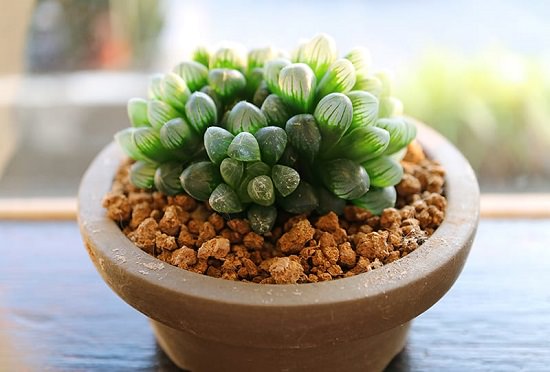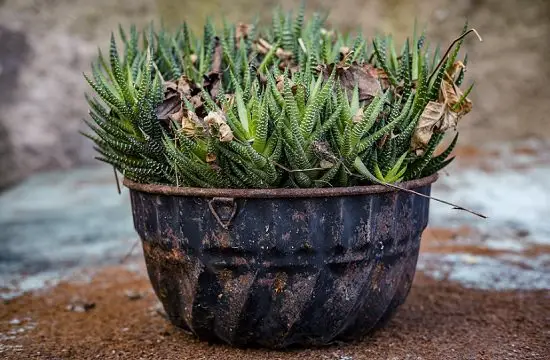Looking brilliant in unusual containers Haworthias are easy-going houseplants to have! Here’s How to Grow Haworthia and more about this beautiful succulent!
Native to South Africa, Haworthia is one of the easiest plants to grow! It is quite similar to the aloe vera plant and can be identified by its pearly warts! It is a slow-growing plant that can grow up to 3-5 inches long. Let’s have a detailed look at How to Grow Haworthia!
Soil pH: 6.6-7.5
Other Names: Zebra cactus, Star window plant, Cushion aloe, Pearl plant
Types of Haworthia
There are around 80 species of Haworthia! You can differentiate between common species by the size of leaves and white markings. Varieties like Zebra cactus, Pearl Plant, and Star Window Plant looks simply stunning in mini pots. These tiny succulents are good for warm climates and can be grown indoors year-round in a cold climate as well.
Check out our article on the best Haworthia varieties here!
Pot Size
A mini 3-5 inches pot with drainage holes at the bottom is fine for most of the haworthia varieties. You can also experiment with coffee mugs and tin cans! Haworthias are excellent dish garden plants as well!
Tip: Shallow pots are considered better than deep pots though some varieties like Haworthia reticulata have large roots that require slightly deeper pots.
Here are some really cute planter ideas for succulents!
How to Propagate Haworthia?
- From Cuttings: Vegetative propagation by taking cuttings is the best and the quickest way to grow Haworthia.
- From Offsets: Most of the varieties produce ‘pups’ or ‘offsets’ at the base. They have individual roots and can be easily cut using a clean and sharp snipper from the parent plant for repotting.
- From Leaves: Alternatively, you can also grow haworthia from leaves. Cut a healthy one from the plant, with the stem tissue, and plant it in a well-draining soil mix.
- From Seeds: Procuring seeds can be a tough task as they are not readily available at garden centers. If you get your hands on them, just sow them in a well-draining soil mix, keeping it moist till the germination, which takes around 2 weeks.
Requirements for Growing Haworthia

Location
Haworthia prefers bright, but not direct sunlight. However, exposure to several hours of morning sun is always good. An East or West-facing window, while growing them indoors, is an ideal spot. Avoid long exposures to the direct scorching sun especially in the afternoon as it can burn the leaves. Simultaneously, if the plant doesn’t get sufficient light, it fades.
Soil
Like all succulents, haworthia doesn’t like wet feet, so going for a well-draining potting mix would be an apt choice. Alternatively, mix soil with pumice, aquarium gravel, or perlite. Do not mix sand in the soil as it can clog the pores.
Water
Watering them once a week in the summer months is ideal. Poke your finger 1 inch into the topsoil to check the moisture level. Water only when it’s dry. Avoid overwatering the plants as it leads to root rot, a common problem with Haworthias.
Temperature
Haworthias prefer warm tropical climate and do best in temperature ranging from 75-90 F (24-32 C). They can tolerate colder weather, but the temperature below 40 F (5 C) is detrimental. Avoid keeping them in the harsh sun, where the temperature exceeds 100 F (38 C)
Haworthia Care

Fertilizer
As Haworthias are a small, slow-growing succulent, it doesn’t need much fertilization. Feed them using a 10-10-10 or 5-10-10 fertilizer diluted to 1/4 strength in their active growing season. Fertilizing once or twice during the entire growing season is enough.
Precautions
- Do not fertilize in winter, if you live in a cold climate.
- Avoid feeding plant that is repotted recently.
- Usually, spring and early summer is the best time for fertilization.
- In hot climates, you can fertilize in late fall.
Re-Potting
It’s not quite common for the plant to outgrow its pot and reaching a maximum height of 4-6 inches as it’s slow-growing! But once you see some pups crowding the mother plant or when the current pot starts to look small, it’s time for repotting.
Pests and Diseases
Haworthia is generally free from pests. Mealybugs can pose a problem to the plant and can be physically removed, easily. The most significant disease is the root rot, which happens from too much moisture. It can be avoided by maintaining a proper watering schedule.



